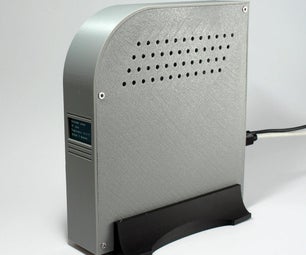Introduction: Game Show Buzzer Lockout System
Introduction
Looking for a cheap alternative for a GAME SHOW BUZZER LOCKOUT SYSTEM. In this project we use construction helmets for the fun factor instead of a box type console and create a very affordable game show buzzer system. The total cost will be about $50-$70 depending on what materials you find around your house. Check out the demonstration video.
Comment if you have any questions or if I missed anything.
Step 1: Materials/Tools/Cost
Materials:
- 3 Construction Helmet
- 3 Momentary Switches
- 3 Flashlights (or just use regular LEDs)
- 3 AAA batteries (came with flashlights)
- 4 Phone jacks (pulled them out from old phones)
- 4 Bolts & 4 Nuts
- 1 Arduino Uno Board
- Lots of Wires (I took apart and used left of ethernet cables)
- 1 ON/OFF Switch (any on/off switch will do)
- 1 Buzzer (RadioShack 6VDC Mini Buzzer)
Tools:
- Drill
- 1/4" & 1/2" drill bits
- Marker
- Sharp Kni fe
- Dremel
- Cut off bit for Dremel
- Sanding bit for Dremel
- Hot Glue
- Soldering Iron and Solder
- Electric Tape
Cost:
- 3 Construction Helmets @ $7.88 ea (ebay.com) = $23.64
- 3 Momentary Switch @ $5.49 for 5 (ebay.com) = $3.29
- 3 Flashlights & AAA batteries (HarborFrieght) $1 ea = $3
- 4 Phone jacks $3.16/old phone (Goodwill x 2) = $6.32
- 4 Bolts & 4 Nuts = FREE (had some)
- 1 Arduino Uno Board (amazon.com) = $27.97
- Wires = FREE (use ethernet cables or any other cable)
- 1 ON/OFF Switch = FREE (had some, can take it off an old device too)
- 1 Buzzer (Radio Shack) = $3.99
My Total Cost: $68.21
Step 2: Programing the Arduino Uno Board
Program Basic Set Up
So the way the Arduino program is coded is as follows:
Switches: S1 = Pin 2
S2 = Pin 3
S3 = Pin 4
Lights: L1 = Pin 5
L2 = Pin 6
L3 = Pin 7
Buzzer: B = Pin 8
Arduino Code (feel free to copy and paste)
// define pins to be used
int S1 = 2; //switch 1
int S2 = 3;
int S3 = 4;
int L1 = 5; // light 1
int L2 = 6;
int L3 = 7;
int B = 8; //buzzer
void setup() { // initialize the digital pins. // assume switches will wire from ground to input pins
pinMode(S1, INPUT_PULLUP);
pinMode(S2, INPUT_PULLUP);
pinMode(S3, INPUT_PULLUP);
pinMode(L1, OUTPUT); // leds wired from output pin to ground }
pinMode(L2, OUTPUT);
pinMode(L3, OUTPUT);
pinMode(B, OUTPUT); // buzzer wired from output pin to ground }
void loop() { if (!digitalRead(S1)) { digitalWrite(L1,HIGH); // turn on lamp 1
digitalWrite(B,HIGH); // turn on buzzer
delay(500); // wait 2 seconds
digitalWrite(B,LOW); // turn off buffer
delay(5000); // wait 28 more seconds
digitalWrite(L1,LOW); // turn off lamp 1 }
if (!digitalRead(S2)) { digitalWrite(L2,HIGH); // turn on lamp 2
digitalWrite(B,HIGH); // turn on buzzer
delay(500); // wait 2 seconds
digitalWrite(B,LOW); // turn off buffer
delay(5000); // wait 28 more seconds
digitalWrite(L2,LOW); // turn off lamp 2 }
if (!digitalRead(S3)) { digitalWrite(L3,HIGH); // turn on lamp 3
digitalWrite(B,HIGH); // turn on buzzer
delay(500); // wait 2 seconds
digitalWrite(B,LOW); // turn off buffer
delay(5000); // wait 28 more seconds
digitalWrite(L3,LOW); // turn off lamp 3 } }
Step 3: Actual Building/Wiring Schematic
For actual building instructions see the attached youtube video.
Attached is the wiring schematic that I used to set up the arduino board.
I don't have the phone jack in the wiring schematic since they act just like connectors from one helmet to another. If need any assistance comment below.









